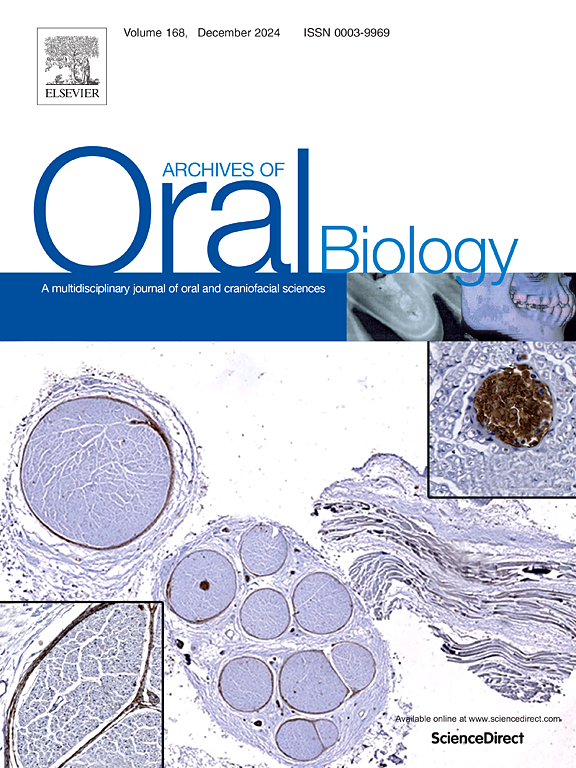液-液相分离相关基因标记预测头颈部鳞状细胞癌的临床结果、肿瘤免疫微环境和化疗反应
IF 2.1
4区 医学
Q2 DENTISTRY, ORAL SURGERY & MEDICINE
引用次数: 0
摘要
液-液相分离(LLPS)与肿瘤发生有关,促使人们研究将LLPS相关基因作为预后标志物。在这里,我们的目标是利用与LLPS相关的基因开发头颈部鳞状细胞癌(HNSCC)的特异性预后标志。设计利用TCGA和GEO数据库中获得的转录序列数据,采用单变量Cox回归、Kaplan-Meier分析和LASSO算法开发LRG特征。此外,我们开发了一种LRG nomogram,将其特征与特定的临床病理特征结合起来,使用多变量Cox回归进行识别。应用生物信息学方法评价LRG特征在预测化疗药物敏感性和免疫浸润方面的临床价值。该特征中的一个基因被敲除,以确认其在体外的作用。结果LRG特征显示了多个独立队列的预后表现。此外,LRG特征评分与肿瘤浸润性免疫细胞的存在呈负相关,并与各种化疗药物的敏感性相关。LRP12沉默可显著抑制HNSCC细胞的增殖、迁移和侵袭,同时诱导HNSCC细胞凋亡。结论我们的研究结果强调了LRG特征和nomogram在预测预后和化疗反应方面的作用,表明其在临床应用中具有良好的前景。本文章由计算机程序翻译,如有差异,请以英文原文为准。
Development of a liquid-liquid phase separation-related genes signature to predict clinical outcomes, tumor immune microenvironment and chemotherapeutic response in head and neck squamous cell carcinoma
Objective
Liquid-liquid phase separation (LLPS) has been linked to oncogenesis, prompting research into LLPS-related genes as prognostic markers. Here, our objective was to develop a prognostic signature specific to head and neck squamous cell carcinoma (HNSCC) utilizing genes associated with LLPS.
Design
The LRG signature was developed using transcriptional sequence data obtained from the TCGA and GEO databases, employing univariate Cox regression, Kaplan-Meier analysis, and LASSO algorithms. Additionally, we developed an LRG nomogram that integrates the signature with specific clinicopathological features, identified using multivariate Cox regression. Clinical value of LRG signature in predicting chemotherapeutic drug sensitivity and immune infiltration was evaluated by bioinformatics approaches. One of the genes in the signature was knocked down to confirm its role in vitro.
Results
The LRG signature demonstrated prognostic performance across multiple independent cohorts. Moreover, LRG signature scores exhibited a negative correlation with the presence of tumor-infiltrating immune cells and were associated with the sensitivities of various chemotherapeutic agents. LRP12 silencing markedly inhibited the proliferation, migration, and invasion of HNSCC cells, while also inducing apoptosis in these cells.
Conclusion
The findings of our study underscore the efficacy of the LRG signature and nomogram in forecasting prognosis and response to chemotherapy, suggesting a favorable outlook for their application in clinical settings.
求助全文
通过发布文献求助,成功后即可免费获取论文全文。
去求助
来源期刊

Archives of oral biology
医学-牙科与口腔外科
CiteScore
5.10
自引率
3.30%
发文量
177
审稿时长
26 days
期刊介绍:
Archives of Oral Biology is an international journal which aims to publish papers of the highest scientific quality in the oral and craniofacial sciences. The journal is particularly interested in research which advances knowledge in the mechanisms of craniofacial development and disease, including:
Cell and molecular biology
Molecular genetics
Immunology
Pathogenesis
Cellular microbiology
Embryology
Syndromology
Forensic dentistry
 求助内容:
求助内容: 应助结果提醒方式:
应助结果提醒方式:


